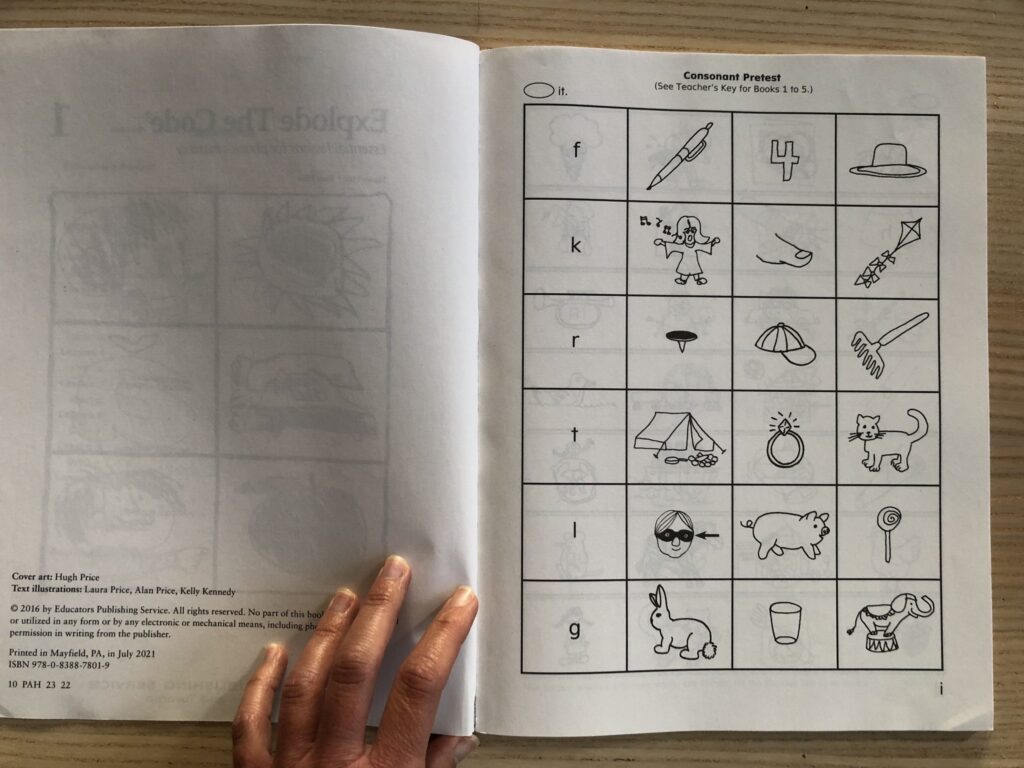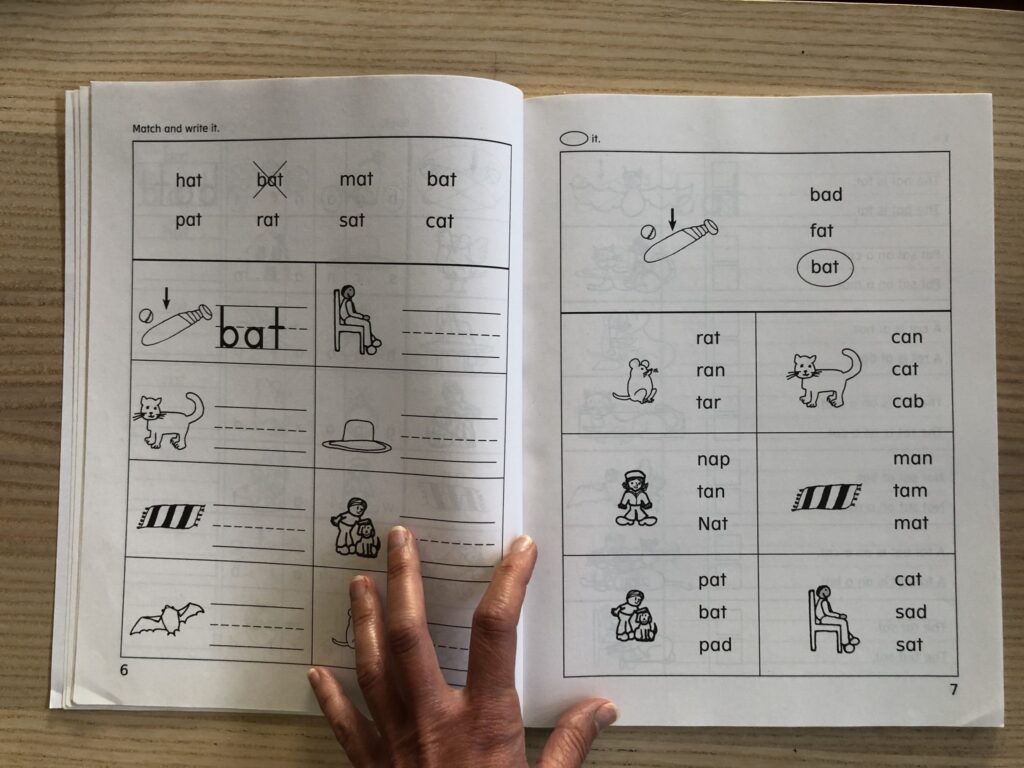Are you looking for a phonics-based literacy curriculum for your child?
One option that has been around since 1976 is Explode the Code. In this review, we’ll take a closer look at what this program offers, its approach to teaching reading, and what you can expect from it.
This learn-to-read program is a “classic,” but still well-regarded, widely-used and relevant these days.
Why? What can you expect? What sort of approach to teaching reading does it use? Is it good? Is it the right choice for your specific needs?
Let’s find out!
*Affiliate Disclosure: Some links lead to Amazon marketplace. As an Amazon associate, I earn from qualifying purchases, at no additional cost to you). This helps keep the information on the blog free and available to everyone.
What is Explode the Code?
The name of this program (Explode the code) already gives you a big clue on what to expect.
It’s all about exploding the code, cracking the phonics code. No surprises here, then. Explode the code is a phonics-based program.
Not only that, it’s also an Orton-Gilligham based curriculum.
What is the Orton-Gilligham Approach to Teaching Reading?
The Orton-Gilingham (OG) approach to teaching reading was developed back in the early 20thcentury by Samuel Torrey Orton, a neuropsychiatrist and pathologist at Columbia University, and the educator and phycologist Anna Gilligham, to help struggling readers and students with dyslexia.
It is an explicit, structured and extremely gradual method of introducing new concepts.
Explicit, by the way, means that you are going to explicitly teach the connections between letters and sounds; as opposed to implicit, where you expect students make their own inferences and learn these connections without learning explicit rules, just by exposure to language and text.
Explicit instruction has been proven to be helpful for all children, as it reduces cognitive load, but particularly good for dyslexic children or children with other learning differences. These students need clear instructions. Sometimes they simply may not be able to make the inferences necessary to fill the gaps when given vague instructions or no instructions at all.
Orton-Gilligham curriculums also use a multisensory approach to teaching reading, for a more holistic learning experience. This is probably what the OG approach is really well-known for.

This was, in fact, quite ground-breaking at the time! The integration of kinaesthetic and tactile strategies with the teaching of auditory and visual concepts.
The idea is to engage all the senses for a more holistic and robust experience. Instruction in multiple formats -text, visual, gesture, audio- activates different cognitive skills facilitating retention in short and long-term memory.
How is the Orton-Gilligham approach implemented in the Explode the code program?
While Explode the Code positions itself as an Orton- Gillinghan based curriculum, I don’t see as many kinetic and multi-sensory experiences/activities/elements as I am used to seeing in other OG programs.
Still, it engages the senses in other ways and has a very strong focus on writing, as we will see later on -which is a multi-sensory activity in itself-, but I don’t see the games, the cards, the tiles… All of these extra elements that I am used to seeing in other OG curriculums!
*Note/Clarification: They do have some picture-letter cards and a multi sensory mat that you can get separately as part of their pre-reading program, “Get Ready for the Code.”Of course, I consider these multi-sensory elements! However, as I said, they are part of their pre-reading program “Get Ready for the Code.” Don’t worry, we will also talk about their pre-reading books later on in this article!
On the other hand, as you’d expect from an Orton-Gilligham curriculum, it is a phonics-based program and it goes all the way down to the phoneme level, which is the smallest unit of sound in words.

Besides, it is very structured, very gradual in the introduction of new concepts. It goes slowly and gives students lots of opportunities for review along the way.
My favourite part of this curriculum are definitely the workbooks. I’ll go through them later on in more detail, so you understand exactly why!
What is included in the Explode the code curriculum? Is it a complete phonics program?
These are the elements included in the program. All of these different elements put together are considered a complete phonics program.
Explode the Workbooks:
8 workbooks + “and a half” workbooks, should your student need to reinforce/review what was covered in the workbook before it. So, for instance 4 1/2 is a review of Explode the Code Workbook #4.
For a detailed sequence of what exactly is covered in each workbook, go to the next section in this article here! See it on Amazon!
See it on Amazon! 
Teachers’ Guides:
How to structure a lesson, how to create an efficient learning routine, supplemental activities and answer-key for selected activities.
The activities on the teachers’ guides can be used and adapted to different settings: whole-class, small-group, and one-on-one learning situations.
One teachers’ guide covers 2 workbooks. So, teacher’s guide #1 covers workbooks #1 and #2, teacher’s guide #2 covers workbooks #2 and #3, and so on and so forth.
Beyond the Code:
Reading comprehension and reasoning skills books. Bear in mind, though, that these books are more advanced than what you need at the beginning when it comes to phonics. Beyond the code book #1, for instance, is going to include advanced concepts, such as diphthongs and r-controlled vowels. So, to be honest, you can’t really start to use them until you are probably done with Explode the code book #3.
The primary goal in the “Beyond the Code” series is to develop reading comprehension and reasoning skills. So, these books include stories for your child to read, but also lots of extra activities for the development of those reading comprehension and reasoning skills. These could be story sequencing activities, story recall activities, think about questions, figure things out activities, etc.
Workbooks Scope and Sequence
Explode the Code Books 1 & Book 1 1/2
Consonant Review
Short Vowel Sounds
Explode the Code Book 2 & Book 2 1/2
Initial and Final Consonant Blends
Explode the Code Book 3 & Book 3 1/2
Long Vowels
Silent-e
Digraphs (sh, th, wh, ch, ng, ck)
Trigraphs (tch)
Vowel teams (ee-ea, ai- ay, oa, ow)
Explode the Code Book 4 & Book 4 1/2
Compound words
Common endings (-ful, -ing, -est, -ed, -ness)
Syllable types (open, closed, ending in -y and -le, diphthong, and three-syllable words
Explode the Code Book 5 & Book 5 1/2
Word families (all-alk, old-olt-oll, ild-ind, qu words)
3-letter blends (thr, shr, scr, str, spr, spi)
Diphthong -ey
Three sounds of -ed
Explode the Code Book 6 & Book 6 1/2
r-controlled vowels (ar, or, er, ir, ur)
Diphthongs (oo, oi-oy, ou-ow, au-aw, ew-ui-ue-ou)
Vowel digraphs (ea, ie, igh)
Explode the Code Book 7
Soft c and g Silent Consonants Word Patterns (ear, ei, eigh)
Digraph ph
Explode the Code Book 8
Advanced suffixes and endings
What is missing in Explode the code?
If you are after are is a full homeschooling curriculum, I don’t think the workbooks will be enough.
In my opinion, you are going to probably also need to get the Teacher’s guides, especially if you don’t know so much about phonics, about the rules, about how to go about structuring a lesson, etc.
On top of this, you are probably going to need to buy a set of decodable books, so your child can practice reading real books that actually match with his/her phonics skills.
Including reading decodable books as part of your routine once your child knows a few letter sounds is highly-recommended.
Unfortunately, Explode the Code doesn’t have phonics readers. It’s not that you have to go and buy them separately. This curriculum simply doesn’t have decodable readers to use along the workbooks and the teaching guides.

So, in my opinion, you’ll have buy a good-quality set of decodable readers and integrate them as part of your child’s reading practice.
This is not such a big deal these days, as there are plenty of good-quality options. The only downside to this is that you’ll have to try to match up the scope and sequence of the books with the scope and sequence of the curriculum, as much as possible. This is doable, but of course it will require some effort from your side, and it’s pretty unlikely that they are going to be a 100% match.
Anyway, if you’re interested in following this route, check this article out for a very comprehensive list of good-quality decodable books.
The Workbooks: The Real Gem in this Curriculum
I’ve already mentioned that I thought the workbooks were very good!
What do I like about the workbooks so much?
Apart from being really affordable, each workbook costs around $15/$16 on Amazon at the time of writing this article (for final prices, check links below), the exercises on the workbooks are extremely well-thought-out and, in some instances, tick lots boxes at the same time.
This means that they will allow children work on sound awareness, phoneme manipulation, learning to read, spell and write all at the same time… which is fantastic!
Besides, some activities are really good fun! And we all know how great (and effective!) it is to have a little laugh while learning!

Another pro in the workbooks is that the exercises always go the same way, anyway. The targeted sounds and the words change, but the gist of the exercises doesn’t.
After a couple of days working the workbooks kids will know exactly what to expect, and you won’t have to spend time explaining what they need to do!
The workbooks are, in my opinion, the real gem in this curriculum, and why I think it’s so highly regarded by many parents and teachers.
Examples of exercises on the workbooks
Let’s go through a few examples, so you have a better understanding of what I mean!
They are taken from Explode the Code Book1, 2nd edition.

Before getting started with this workbook, by the way, bear in mind that your child should know the consonant sounds and consonant lowercase letters.
In fact, the first thing in the book is a consonant pre-test, as shown on the picture below. Examples from pages #4 and #5, that is very early in our learn-to-read journey!
Examples from pages #4 and #5, that is very early in our learn-to-read journey!

Page #4 says “Read, copy and circle it.” Simple right? Well? You are actually reading, matching it to a picture, which is a fun to do and a very appropriate activity for children at this time… and writing!
Page #5 says “Spell.” In this exercise, your kid is already learning to spell (or encode) by listening to the sounds in words. This activity helps kids learn very naturally, from the very beginning, that the spelling in words is not random. Also, as they are forced to listen to the individual sounds in words, they are also working towards their Phonemic Awareness skills. Since they have to write down the words as well, they are also working on their writing.
I also like how the activity is presented in a way that is not overwhelming for children. It gives them options to pick from. Notice how for each sound, children have two letters to pick from. And, of course, we are working with simple three letter words (CVC words).
The image below shows pages #6 and #7.

Page #6 says “Match and write it.” A little bit more challenging, but the idea is the same. Sound it out, naturally realize how just by changing the first sound in a word you get many different words (e.g., hat, pat, rat, mat, sat, bat, cat). This is, again, working towards your child’s sound awareness and phoneme manipulation skills. Then, since she/he has to write the words down, he/she will be practicing his/her writing skills.
Page #7 says: “Circle it” (circle the right word). Again, we are practicing our reading skills, but in very controlled way, in a not-so-overwhelming way, because, again, we have options to pick from. Very appropriate for children at this point.
My last example is in page #40. It says: “Cross it.”

You have to pick the right sentence to match the picture. Good exercise, of course! However, what I really like is that the sentences and the pictures tend to be funny!
Other essential information about Explode the Code
- If you are just starting out, there are three pre-reading workbooks called “Get ready for the Code” A, B and C. In these 3 books, kids learn to identify consonants sounds, they learn their written lowercase forms and their sound-symbol correspondences. You can also get (separately) a wall chart with felt objects representing a keyword for the 26 letters of the alphabet. The wall chart also includes an activity book with instructions for over 30 games you can play using the wall chart.
- The “Explode the code” workbook series consists of 8 books. Your child will start with vowel sounds and patterns (remember he/she has already learned the consonant sounds in “Get Ready for the Code”) and progress through consonant blends, digraphs, syllables and suffixes. At the beginning of book #1, you’ve got a pre-test to see if your child is ready to start. At the end of each book you have a post test, so you can see whether your child needs extra practice for the concepts covered in that workbook or not.
If he/she needs extra practice, you can get the “and a half workbooks.” Remember, you probably only need to get them if you detect your student needs further practice with what was covered in the previous workbook.
- If you are going to use this as your main literacy curriculum (or if you are going to use this program in the classroom), then I think you’ll probably need to also get the teacher’s guides. One teachers’ guide covers two workbooks.
- This curriculum will take your student to approximately to 4th grade level.
-
There’s an online version of this program, that I haven’t personally tried. What I thought was interesting about it is that it’s got what they call “adaptive” technology, so the content is automatically adjusted to the student’s performance.
-
Another interesting resource that I haven’t tried either is “Explode the Code for English Language Learners.”
Cons of Explode the Code
- If you are going to get it as your main curriculum, it can get expensive when you add up all the elements that you need to get.
- There are other alternatives available today that -in my opinion do a better job- at certain things that are really important when it comes to learning to read and that so many children struggle with. For instance, teaching different strategies for blending, and especially what to do when your child struggles with this. This is very common, and I don’t see so m information about this KEY topic on the teacher’s guide. I think that it sort of assumes that you, parent/teacher will know how to go about it.
- It also falls short of reading practice at the beginning. As mentioned before, there are no readers with this program.
Final thoughts
Although I appreciate the value of this curriculum as a classic that has stood the test of time, and I love their workbooks, there are a few things that I think could be improved, should you decide to pick it as your primary curriculum.
The Teachers’ Guides: There are other alternatives available today that, in my opinion, twill provide you more guidance should your child struggle with certain crucial aspects of learning to read, such us blending sounds.
Lack of reading practice materials (decodable books) at the beginning.
I personally use this curriculum to reinforce learning with the workbooks, not as my main curriculum.
If after reading this review, you are still unsure and want to look into some other alternative literacy curriculums, you may want to check these other articles:
Go to Explode the Code on Amazon!

Hey there! I’m Laura – an author, YouTuber, blogger, and the creator of the “Learning Reading Hub” platform. I created this space to dive into the world of reading instruction and to shout from the rooftops about how vital it is to use the right methods for teaching reading. I’ve got a TEYL certification (Teaching English to Young Learners), plus a Journalism degree from the University of Navarra in Spain, along with a Master’s Degree in Communication.
I’ve always loved digging into research, jotting down my thoughts, connecting with people, and sharing what makes me tick. With a background in marketing, digital projects, and the education scene (especially language learning), I’m all about wearing different hats.
When my first kid needed to learn how to read, it opened my eyes to the challenges and complexities involved. This journey took me through a rollercoaster of self-teaching, eye-opening discoveries, and yeah, some letdowns too. There’s so much conflicting info out there, along with methods that just don’t cut it. And let’s face it, these issues are way too common.
Now, I’m all about channeling that passion (without sounding like a know-it-all!) and sharing my journey. My mission? Making it easier for those who are on the same path I once was.
My heart’s with my family and the amazing Learning Reading Hub project. I live with my husband and two little ones, raising them in a bi-lingual environment (English and Spanish).












